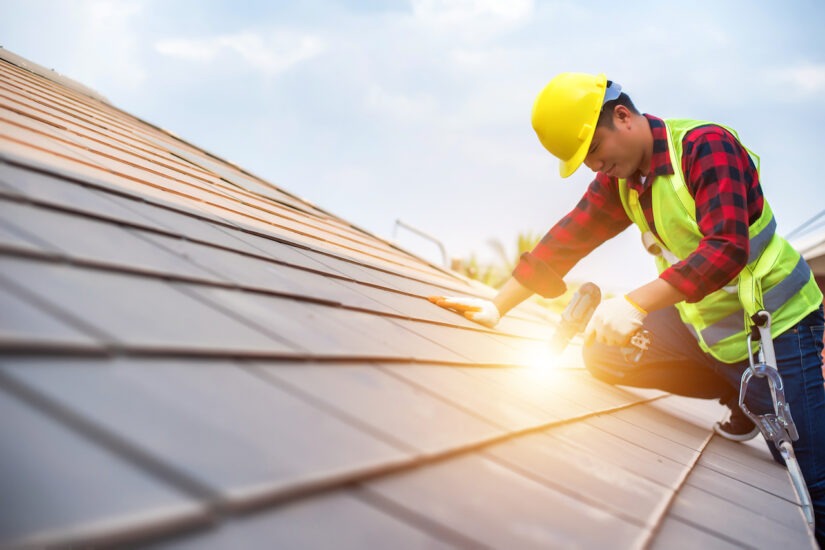Did you know that nearly 75% of homeowners will need to replace their roof at least once during their lifetime? If you find yourself in this situation, it’s essential to understand the process and how to prepare for it. From recognizing the signs that indicate a replacement is necessary to choosing the right materials and contractors, each step can significantly impact the outcome. So, what should you expect during this process, and how can you ensure everything goes smoothly? Let’s explore these important aspects together.

Understanding Roof Replacement
Understanding Roof Replacement Services involves recognizing the signs that indicate it’s time for a new roof and knowing the process that follows.
A typical roof lifespan ranges from 20 to 50 years, depending on materials and maintenance. When your roof nears its end, you’ll want to assess your insurance coverage, as many policies may help offset replacement costs.
Before starting, gather estimates from reputable contractors and check if your insurance will cover repairs or a full replacement.
Ensure you understand the warranty options available for both materials and workmanship. This knowledge not only prepares you financially but also ensures you select a solution that meets your long-term needs, safeguarding your investment and maintaining your home’s structural integrity.
Signs You Need a Replacement
Recognizing the signs that indicate a roof replacement is necessary is crucial for homeowners. If your roof is approaching or has exceeded its expected roof lifespan, usually 20-25 years, it’s time to evaluate its condition.
Look for missing shingles, excessive granule loss, or curling edges, which can signal deterioration. Water stains on ceilings or walls indicate leaks that reflect potential structural issues.
Additionally, if you notice sagging or bowing in your roofline, it could mean serious damage. Weather impact plays a significant role; harsh conditions like hail, strong winds, or heavy snow can accelerate wear and tear.
Don’t wait for small problems to escalate—addressing these signs early can prevent costly repairs down the line.
Choosing the Right Materials
Once you’ve determined that a roof replacement is necessary, the next step is to select the right materials for your new roof.
Consider factors like material durability and cost comparison when making your choice. Asphalt shingles are popular due to their affordability and decent lifespan, while metal roofs offer superior durability and energy efficiency, albeit at a higher initial cost.
If you’re looking for longevity, slate or tile may be ideal, but they can significantly increase your budget.
Be sure to assess local climate conditions, as some materials perform better in specific environments.
Ultimately, weighing the long-term benefits against the upfront costs will help you choose the best materials for your needs and ensure a successful roof replacement.
Hiring a Roofing Contractor
Finding a qualified roofing contractor is crucial for ensuring a smooth and successful roof replacement process.
Start by verifying contractor qualifications, such as licenses, insurance, and a solid reputation in your area. Check reviews and ask for references from past clients to gauge their reliability and workmanship.
Once you have a shortlist, request detailed project estimates from each contractor. These estimates should outline the scope of work, materials used, and a clear timeline for completion.
Don’t hesitate to ask questions about their approach and experience with similar projects. By carefully evaluating these factors, you’ll be better positioned to make an informed decision, ensuring your roof replacement meets both your needs and expectations.
Preparing Your Home
As you prepare for your roof replacement, it’s essential to take proactive steps to protect your home and ensure a smooth process.
Start by clearing your yard of any debris, outdoor furniture, and delicate plants to facilitate easy access for the roofing crew. Consider your roof landscaping; trimming overhanging branches will prevent damage to both your landscape and the new roof.
Inside, prioritize interior protection by moving furniture away from windows and doors. Cover items with drop cloths to prevent dust and debris from settling on surfaces.
Finally, notify your neighbors about the upcoming work to minimize disruptions and foster a cooperative environment.
The Replacement Process
The replacement process begins with an initial inspection to assess the condition of your roof and identify any underlying issues.
Once the assessment is complete, you’ll explore various material selection options that best suit your needs and budget.
Initial Inspection Steps
A thorough initial inspection is crucial for ensuring a successful roof replacement. During this stage, a comprehensive roof assessment and damage evaluation are conducted to identify any underlying issues.
Here’s what you can expect:
- Visual Inspection: The contractor will examine the exterior for visible signs of wear.
- Structural Analysis: They’ll assess the roof deck and supports for stability.
- Interior Checks: Inspecting the attic for leaks or moisture issues is vital.
- Documentation: They’ll document findings for a detailed report and estimate.
This initial inspection helps determine the extent of repairs needed and guides the selection of appropriate materials.
Material Selection Options
After completing the initial inspection, it’s time to consider the material selection options for your roof replacement.
You’ll want to evaluate energy efficiency, as some materials can significantly lower your utility bills.
Consider aesthetic appeal; the right roofing can enhance your home’s exterior.
Conduct a cost comparison, weighing initial investment against long-term savings.
Durability factors are crucial—opt for materials that withstand local climate conditions.
Additionally, explore sustainability options; recycled or eco-friendly materials can minimize your environmental impact.
Keep local regulations in mind, as they may dictate specific materials or installation methods.
Lastly, ensure the chosen materials align with your preferred installation methods to avoid complications during the replacement process.
Installation Timeline Overview
Understanding the installation timeline is crucial for a smooth roof replacement process. Typically, the project duration can vary from several days to a couple of weeks, depending on factors like weather and roof complexity.
Here’s what to expect during the replacement:
- Preparation: The crew will assess your roof and gather necessary materials.
- Removal: Old roofing materials are stripped away using efficient installation techniques.
- Installation: New materials are carefully installed, ensuring proper sealing and alignment.
- Cleanup: The crew will clear debris and ensure your property is left tidy.
Post-Replacement Maintenance
After replacing your roof, it’s crucial to implement a routine maintenance schedule to ensure its longevity.
Regular inspections help you identify potential issues like leaks early on, while cleaning debris prevents water accumulation that can lead to damage.
Staying proactive in these areas will protect your investment and maintain your roof’s performance over time.
Regular Inspections Importance
Regular inspections are crucial for maintaining the integrity of your new roof after replacement. By scheduling routine evaluations, you can significantly extend your roof’s lifespan and identify issues early on.
Aim for an inspection frequency of at least twice a year, and after severe weather events. Here’s what to focus on during inspections:
- Check for loose or missing shingles: Addressing these issues promptly prevents further damage.
- Examine flashings and seals: Ensure they’re intact to avoid leaks.
- Inspect gutters and downspouts: Clogged systems can lead to water backup and roof damage.
- Look for signs of wear: Early detection of wear can save you costly repairs down the line.
Regular inspections help ensure your investment remains protected.
Cleaning Debris Accumulation
Maintaining your roof goes beyond regular inspections; it also involves keeping it free from debris accumulation. Proper debris management is crucial for ensuring your roof’s longevity and performance.
Start by regularly assessing your roof for leaves, branches, and other materials that can trap moisture and promote rot. Implement effective cleanup strategies, such as using a leaf blower or a soft-bristle broom to clear the surface without causing damage.
Don’t forget to check your gutters, as clogged drainage can lead to water pooling and potential leaks. By establishing a routine for debris removal, you’ll not only protect your investment but also enhance your roof’s efficiency and aesthetic appeal.
Make debris management a priority for optimal post-replacement maintenance.
Monitoring Leakage Issues
Leaks can sneak up on even the most diligent homeowners, making it essential to monitor your roof for any signs of water intrusion after a replacement.
Regular leak detection and moisture assessment can help you identify issues before they escalate. Here are some key steps to consider:
- Inspect ceilings and walls for water stains or discoloration.
- Check attic insulation for dampness or mold growth.
- Examine roof flashings and joints for any gaps or cracks.
- Conduct routine maintenance checks after heavy rain or storms.
Why You Choose Pure Energy Roofing Company
Serving Brighton, Ann Arbor, and the surrounding areas of Southeast Michigan, Pure Energy Roofing Company has become a reliable name in roofing services. Owned by Adrian Beavers and Matt Masters, this family-operated company provides specialized solutions like roof replacement, repairs, gutter replacements, and attic insulation. Their Owens Corning Certified Contractor status ensures top-tier materials and skilled workmanship, setting them apart in the industry. With a focus on customer satisfaction, they pride themselves on delivering professional, high-quality results tailored to each client.
Conclusion
In the realm of homeownership, a roof replacement is often seen as a necessary rite of passage. By staying vigilant and addressing signs of wear early, you can ensure a smooth transition to your new roof. Remember, investing in quality materials and a skilled contractor pays off in the long run. After the work is done, don’t forget to nurture your roof with regular maintenance. Embrace this opportunity to enhance your home’s protection and value for years to come.
